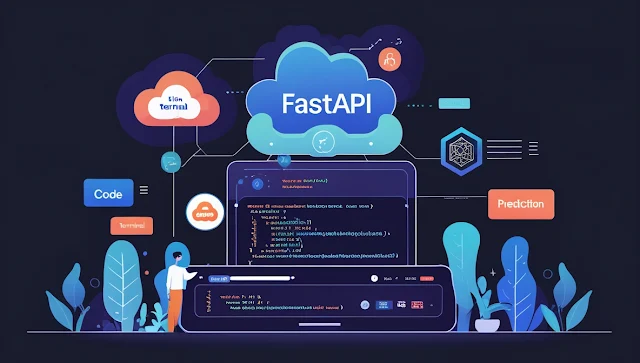Introduction: Why API Deployment Matters in Machine Learning
Deploying machine learning (ML) models is the bridge between innovation and practical impact. Data scientists often develop powerful predictive models, but if those models aren’t deployed, they cannot deliver value. One of the most accessible and scalable methods to serve ML models is by deploying them as APIs. In this post, we will explore the end-to-end deployment of ML models as APIs using Flask or FastAPI, giving you a complete hands-on walkthrough.
What Does It Mean to Deploy ML Models as APIs?
When we say “deploying ML models as APIs,” we mean wrapping a trained ML model inside a web framework that exposes endpoints, allowing users or applications to send input and receive model predictions in real time—just like asking a question and getting an answer.
Keyword Integrated Statement:
According to MLOps experts, deploying ML models as APIs with Flask or FastAPI is the most efficient method to operationalise machine learning solutions.
Step-by-Step Guide: End-to-End Deployment of ML Models as APIs
Step 1: Train and Save Your ML Model
We'll begin with a simple scikit-learn model for illustrative purposes.
# model_training.py
from sklearn.datasets import load_iris
from sklearn.ensemble import RandomForestClassifier
import joblib
iris = load_iris()
X, y = iris.data, iris.target
clf = RandomForestClassifier()
clf.fit(X, y)
# Save the model
joblib.dump(clf, 'iris_model.pkl')
Step 2: Create the API Using Flask
Let’s deploy the above model using Flask first.
📦 Requirements
pip install flask joblib scikit-learn
🧩 Flask API Code
# app_flask.py
from flask import Flask, request, jsonify
import joblib
import numpy as np
app = Flask(__name__)
model = joblib.load('iris_model.pkl')
@app.route('/predict', methods=['POST'])
def predict():
data = request.get_json(force=True)
prediction = model.predict([np.array(data['features'])])
return jsonify({'prediction': int(prediction[0])})
if __name__ == '__main__':
app.run(debug=True)
Run using:
python app_flask.py
Send a request using:
curl -X POST -H "Content-Type: application/json" \
-d '{"features": [5.1, 3.5, 1.4, 0.2]}' \
http://127.0.0.1:5000/predictStep 3: Create the API Using FastAPI (Alternative)
FastAPI is modern, async-friendly, and faster. It's preferred for production.
📦 Requirements
pip install fastapi uvicorn joblib scikit-learn
🧩 FastAPI API Code
# app_fastapi.py
from fastapi import FastAPI
from pydantic import BaseModel
import joblib
import numpy as np
class IrisRequest(BaseModel):
features: list
app = FastAPI()
model = joblib.load('iris_model.pkl')
@app.post("/predict")
def predict(data: IrisRequest):
prediction = model.predict([np.array(data.features)])
return {"prediction": int(prediction[0])}
Run using:
uvicorn app_fastapi:app --reload
Visit Swagger UI at: http://127.0.0.1:8000/docs
Step 4: Deploy to a Cloud Platform (e.g., Render or Heroku)
Let’s deploy the FastAPI app using Render.com (simpler than Heroku).
📤 Upload to GitHub
-
Push your
app_fastapi.pyandiris_model.pklto a GitHub repo. -
Add a
requirements.txtfile:fastapi uvicorn joblib scikit-learn -
Add a
startcommand inrender.yamlor use:uvicorn app_fastapi:app --host 0.0.0.0 --port 10000
🌐 Create a Web Service on Render
-
Go to https://render.com
-
Create a new web service → Connect to GitHub repo → Choose Python environment
-
Set build command:
pip install -r requirements.txt -
Set start command as above.
Done! You now have a live ML API.
Responsive API Design & Testing Tools
Whether you choose Flask or FastAPI, your ML model is now accessible via HTTP POST requests. For testing and building a frontend or mobile interface, use:
-
Postman – for manual testing.
-
Swagger UI – built-in with FastAPI.
-
HTML/Javascript Frontend – for end-user interaction.
Flask vs FastAPI for Deploying ML Models as APIs
| Feature | Flask | FastAPI |
|---|---|---|
| Speed | Moderate | Very Fast (async) |
| Type Checking | Manual | Automatic with Pydantic |
| API Docs | Manual with Swagger plugin | Auto-generated Swagger & Redoc |
| Learning Curve | Lower | Slightly Higher but Worthwhile |
Expert Insight:
"For lightweight tasks and quick POCs, Flask is fantastic. For scalable ML services, FastAPI wins with modern design," says Dr. Amit Raj, AI Deployment Specialist.
Final Suggestions: Making Your ML API Production-Ready
-
Use
gunicornfor Flask in production. -
Containerise using Docker.
-
Add error handling for invalid inputs.
-
Limit model load to once at startup.
-
Enable CORS for cross-origin frontend calls.
-
Monitor API logs and performance using tools like Prometheus or Sentry.
Conclusion
Deploying ML models as APIs with Flask or FastAPI allows you to serve intelligent predictions in real time. This blog post covered the end-to-end deployment of ML models as APIs, from training to production. Whether you’re a beginner looking for a working prototype or a developer building a robust ML microservice, this guide equips you with both tools and practical know-how.
Disclaimer:
While I am not a certified machine learning engineer or data scientist, I
have thoroughly researched this topic using trusted academic sources, official
documentation, expert insights, and widely accepted industry practices to
compile this guide. This post is intended to support your learning journey by
offering helpful explanations and practical examples. However, for high-stakes
projects or professional deployment scenarios, consulting experienced ML
professionals or domain experts is strongly recommended.
Your suggestions and views on machine learning are welcome—please share them
below!

